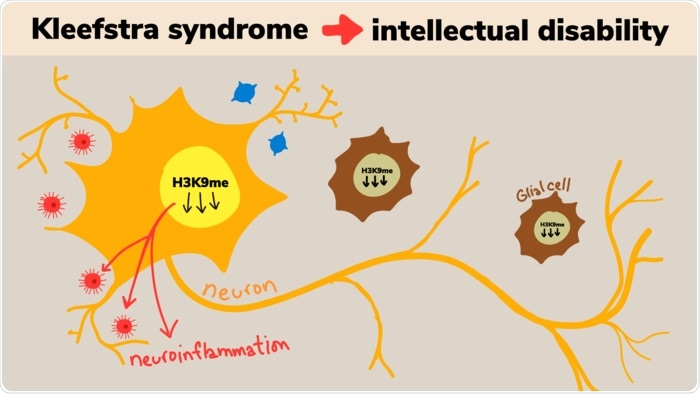Scientists from the RIKEN Cluster for Pioneering Research (CPR) in Japan announced the reversal of Kleefstra syndrome—a genetic disorder leading to intellectual disability. The syndrome was reversed after birth in a mouse model of the disease.

Kleefstra syndrome is associated with reduced H9K3 methylation in the brain, which leads to intellectual disability. The new study found greater microglia activation and neuroinflammation in a mouse model of the disease. Neural and behavioral symptoms were reduced when GLP was provided after birth. Image Credit: RIKEN.
Yoichi Shinkai led a series of experiments and demonstrated how postnatal treatment resulted in bettered symptoms, both in behavior and in the brain. The research was published in iScience, a scientific journal.
Generally, individuals acquire two good copies of the majority of the genes, one from each parent. And in Kleefstra syndrome, one copy of the EHMT1 gene is missing or mutated; as a result, the normal amount of GLP is halved.
GLP is a protein that regulates genes related to brain development through a mechanism named H3K9 methylation. The reduced amount of GLP lessens H3K9 methylation, along with impaired normal development of the connections between neurons. This results in intellectual disability and autistic-like symptoms.
We still don’t know if Kleefstra syndrome is a curable disease after birth or how this epigenetic dysregulation leads to the neurological disorder. Our studies in mice have provided new information about what causes the behavioral abnormalities associated with the syndrome and have shown that a cure is a real possibility in the future.”
Yoichi Shinkai, Cluster for Pioneering Research, RIKEN
Assuming that extra GLP could be a potent treatment, the scientists carried out a series of experiments in mice that were engineered to contain only one good copy of the EHMT1 gene. The brains of these mice exhibited characteristics of the human condition, including 40% reduced GLP and 30% reduced H3K9 methylation.
The mice also showcased various behaviors found in individuals with Kleefstra syndrome, like greater anxiety and reduced locomotion. After carrying out each experiment, the team examined these factors and matched them to normal mice to observe the effectiveness of the treatment.
In two experiments, the researchers artificially triggered GLP production after birth—once specific to adult neurons in the brain and once throughout the whole brain. Three- to four-week-old juvenile mice subjected to treatment swiftly rescued H3K9 methylation and GLP levels in the brain in both tests.
Behavior improvement was observed several weeks later only when GLP was heightened throughout the whole brain. Eventually, brain and behavioral symptoms were rescued successfully by the treatment that heightened GLP levels throughout the brain after mice had already become juveniles.
The scientists then explored why the treatment worked only when GLP was increased throughout the brain, not just in neurons. Assuming that the disorder abnormally activates microglia cells in the brain—familiar to control immune responses like inflammation—the researchers analyzed and discovered a familiar inflammatory response in the brains of the mice models, along with higher amounts of activated microglial cells.
By knocking out a major protein participating in the inflammatory response, certain brain abnormalities triggered by inflammation were reversed; however, this did not change the behavior.
This means that brain inflammation is only part of the story. To have a complete understanding of the disease, we need to find out what happens in other non-neural cells when we increase GLP.”
Ayumi Yamada, Study First Author, Cluster for Pioneering Research, RIKEN
These observations are the foremost to report neuro-inflammation in Kleefstra syndrome, and hence the next step is to identify if it also appears in the human condition. Shinkai presumes that the chances are huge and also adds he would not be astonished if other neurological diseases resulting from epigenetic dysregulation were also linked to abnormal inflammation in the brain.
Although we don’t yet know if our findings will be applicable to patients with Kleefstra syndrome. We have shown that a cure after birth is possible and believe this will bring hope to patients and their families.”
Yoichi Shinkai, Cluster for Pioneering Research, RIKEN
Source:
Journal reference:
Yamada, A., et al. (2021) Derepression of inflammation-related genes link to microglia activation and neural maturation defect in a mouse model of Kleefstra syndrome. iScience, doi.org/10.1016/j.isci.2021.102741.